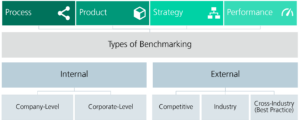Benchmarking is the structured comparison with top performers to set meaningful standards and improvement goals for your own organization. By integrating established management methods and applying them consistently and holistically, benchmarking can drive lasting success.
Benchmarking can be applied to various dimensions of an organization:
-
Process Benchmarking: Focuses on improving specific workflows and operational procedures by learning from leading practices.
-
Product Benchmarking: Compares product features, performance, or design to optimize offerings and meet market demands.
-
Strategic Benchmarking: Involves studying long-term strategies, business models, and innovation roadmaps to inform future positioning.
-
Performance Benchmarking: Measures key performance indicators (KPIs) and outcomes to identify efficiency and effectiveness gaps.

Benchmarking can be classified by the organizational scope and comparison partner:
🔹 Internal Benchmarking
-
Company-Level: Compares departments or units within the same organization.
-
Corporate-Level: Compares business units across subsidiaries or locations within a corporate group.
🔸 External Benchmarking
-
Competitive: Compares with direct market competitors.
-
Industry: Compares with organizations in the same sector but not direct competitors.
-
Cross-Industry (Best Practice): Compares with top-performing organizations regardless of industry, focusing on functional excellence and innovation.
